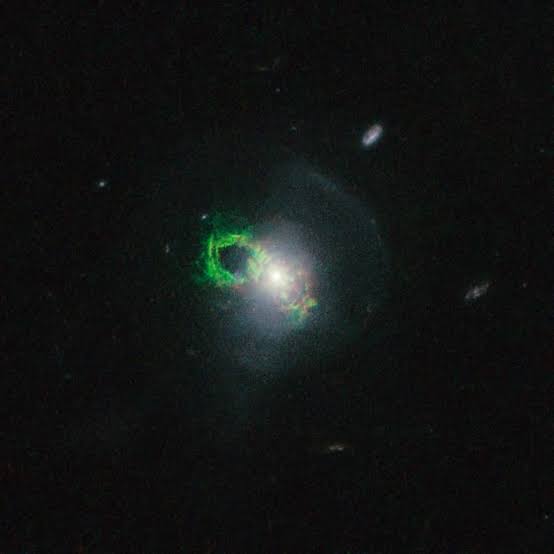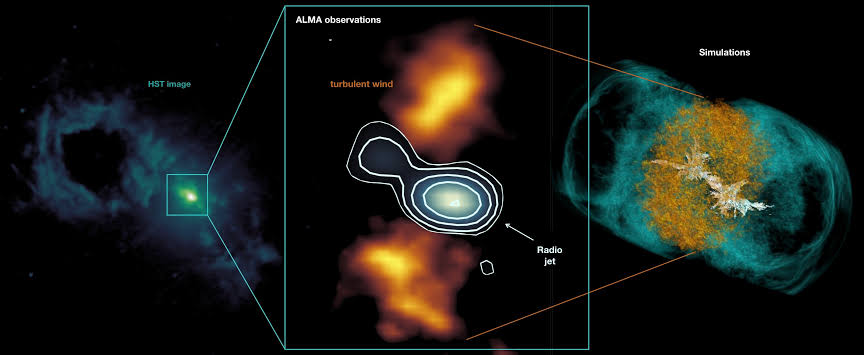Active galactic nuclei are a potent phenomenon that result from supermassive black holes consuming matter in the galactic centre. (AGN). These AGN have the ability to discharge energy in the form of jets that crash with galactic gas and clouds while travelling at almost the speed of light.
Although the precise circumstances that set off this process are still not completely known, this collision can produce strong winds that sweep away gas from the galaxy.
The Impact of Jets on Galaxies: Altering Their Fate and Shape
Supermassive black hole jets have an impact on galaxy composition and are crucial to the evolution of galaxies. Gas is heated by strong radio jets, which prevents the birth of new stars and changes the course of galaxies.
The most potent radio jets, located in “radio-loud” galaxies, are in charge of substantially altering the fate of galaxies because they heat the gas, which suppresses galaxy development and new star formation.
According to computer simulations, as jets move further into the galaxy, they create bubbles that change the shape of the gas in the area. Unexpectedly, weaker jets, such as those in “radio-quiet” galaxies, can harm the surrounding medium more than stronger ones.
Anelise Audibert, an IAC researcher, and a group of international scientists have found a fantastic opportunity to explore the interaction between a radio jet and cold plasma surrounding a gigantic quasar. They have decided to investigate the Teacup galaxy, a 1.3 billion light-year distant radio-quiet quasar.
The name of the galaxy is derived from optical and radio scans, which show expanding bubbles that resemble the handle of a teacup. Another noteworthy characteristic in the core region is the youthful, compact radio jet, which is just slightly inclined to the galaxy’s disc.
ALMA telescope captures unprecedented detail of Teacup’s core

A compact radio jet’s interaction with the frigid plasma encircling a large quasar has been studied in detail thanks to The Teacup Galaxy. Astronomers have long been fascinated by the teacup-shaped expanding bubbles that may be seen in optical and radio photographs of the object.
However, the galaxy’s core has shown to be the most fascinating part of the entire galaxy. The chilly, thick gas in the centre of the Teacup has been observed and studied in unprecedented detail by researchers using the potent Atacama Large Millimeter/submillimeter Array (ALMA) telescope. According to their research, the small jet is heating the gas, speeding it, and disturbing its distribution despite having a low power.
Understanding the relationship between cold gas disc and jet crucial for galactic development research.
The team was able to characterise the cold, dense gas at the centre of the Teacup with unprecedented clarity because to the ALMA observations, particularly by spotting the emission of carbon monoxide molecules, which can only exist under specific density and temperature conditions.
The results showed that the small jet, despite its low power, altered the distribution of gas, heated it, and unusually accelerated it. This relationship between the cold gas disc and the jet has been identified as a key element in effectively generating these lateral winds and are significant in understanding mechanics of galactic evolution.
In radio-quiet galaxies, low-power jets affect the surrounding gas more than previously imagined. According to Cristina Ramos Almeida, an IAC researcher, this will have an impact on the galaxy’s capacity to produce new stars.
The next step is to use MEGARA, an instrument mounted on the Gran Telescopio Canarias (GTC), to observe a bigger sample of radio-quiet quasars and evaluate modifications in star formation brought on by winds. Under the direction of C. Ramos Almeida at the IAC, the QSOFEED project seeks to understand how the winds from supermassive black holes affect the galaxies that host them.
Conclusion:
The identification of the bubble-blowing relativistic jets in the centre area of the Teacup galaxy provides insight into the complex processes at work in the cosmos. The work demonstrates that even radio-quiet galaxies can have a major influence on their surroundings and emphasises the significance of low-power jets in altering the galaxies around them.
Combining computer simulations with the team’s use of ALMA to study and characterise the cold, dense gas in the galaxy’s centre with remarkable precision, these observations have shed important new light on the intricate relationship between jets and the gas around them. The discoveries will help us comprehend how galaxies evolve and how supermassive black holes impact the cosmos.
